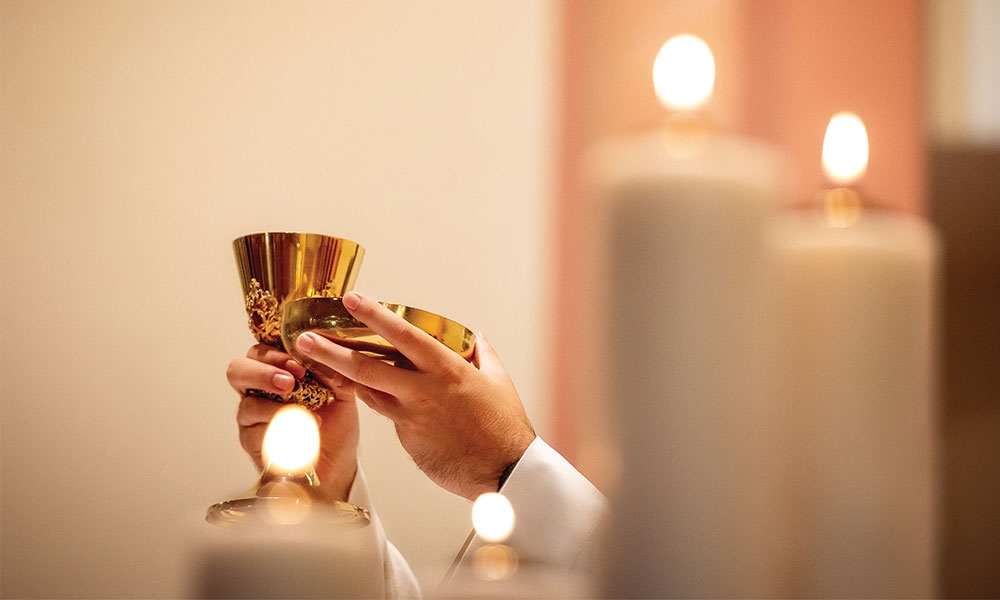
Strengthening your marriage with the Liturgy of the Eucharist
In the previous column we focused on how the Liturgy of the Word can bring a married couple closer together and how it nourishes them by Christ’s presence in the Word. Now, we turn to the second part of the Mass, the Liturgy of the Eucharist, where we encounter God’s self-giving love which deepens and gives shape to the marital relationship.
In the previous column we focused on how the Liturgy of the Word can bring a married couple closer together and how it nourishes them by Christ’s presence in the Word. Now, we turn to the second part of the Mass, the Liturgy of the Eucharist, where we encounter God’s self-giving love which deepens and gives shape to the marital relationship.
Presentation of the Gifts and Preparation of the Altar
The Offertory Rites which begin the Liturgy of the Eucharist not only prepare and bless the bread and wine that will be consecrated, but also our own gifts which we offer on the altar. As a couple, our work of sacrifice and love which we bring to our marriage is being offered to God. As the altar is prepared, we focus on how our marriage and our lives are joined to Christ’s perfect sacrifice and are made holy by God in the Eucharistic Prayer.
Eucharistic Prayer
The Eucharistic Prayer is the summit of the Mass. It is a prayer of petition, adoration, reparation and thanksgiving in which Christ, in the person of the priest, offers himself to his Father. By virtue of our baptism, we all – including married couples – are able to offer the sacrifice with him. As the priest presents us, our prayers and all of creation to God, we can focus on all we are thankful for in our marriage and family life and allow our gratitude for one another to seep into our hearts.
During the consecration of the bread and wine, we are made present in a unique way to Christ’s sacrifice of love on Calvary. As the bread and wine are transformed into Jesus’ body, blood, soul and divinity, we, in turn, are transformed and enriched in our ability to sacrifice for one another. In fact, the image of Christian marriage is commonly employed to describe Jesus’ sacrifice on the cross – starting as far back as St. Paul! In his Letter to the Ephesians, St. Paul called husbands to love their wives “even as Christ loved the church.” (5:25) Thus, Jesus’ self-giving love is the model par excellence for married love. In the Eucharistic Prayer II, we pray that God bring us and the whole Church to the fullness of charity. Our marriages can be transformed when we hope and pray for that.
Invitation to Communion
Praying the Lord’s Prayer together and then offering one another a Sign of Peace can be reconciling for the married couple as we set aside what separates us and come together in a special way before receiving Communion. Receiving the Eucharist unites us to Christ, gives us grace to live our marriage in long-lasting love and fidelity, and brings about unity and communion with one another. After experiencing so great a gift, in the Concluding Rites, we receive a final blessing and are dismissed to bring Christ’s love into the world.
Final thoughts
Being more conscious of the ways the Mass can strengthen our marriage allows us to see how our everyday married lives are oriented toward God. It is an invitation to reflect on how we encounter Christ and offer our very selves to God not only in our community of faith, but also in our home. If we pray the Mass with love and devotion, it will open our hearts to greater love and charity for God and for one another.
Tracy Rodenborn lives in East Greenwich, Rhode Island, with her husband, Steve, and four children. Having had ministry positions in Catholic parishes and high schools throughout the country, she now works with the University of Notre Dame’s Satellite Theological Education Program.



